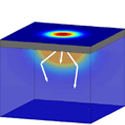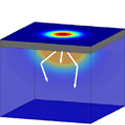Measuring how far vibrations travel
Modifying heat flow can improve many technologies. For example, thermoelectric devices, which swap temperature differences for electrical energy, are ideally made from materials that are good electrical conductors, but poor conductors of heat. Recently, researchers have been exploring how shaping structures at the nanoscale can give them extra control over these properties.
The new effects arise when phonons, the quanta of vibrational energy, propagate larger distances than the nanostructures themselves. But measuring the mean-free path over which phonons move without scattering is not easy. In Physical Review Letters, Austin Minnich, now at the California Institute of Technology in Pasadena, and his colleagues exploit one small-size effect to get experimental information about phonon mean-free paths.
Minnich et al. do not actually employ small structures, but instead measure the temperature rise caused by heating a small spot in a uniform metal coating on a silicon crystal. To probe different length scales, they focus their short laser pulses to different sizes. At room temperature, the size doesn’t affect how the heat moves into the silicon. But when the crystal is cooled to tens of kelvin, the mean-free path of some phonons becomes larger than the spots. Calculations show that because the heat no longer diffuses, it flows more slowly from smaller spots, just as seen in the experiments.
The focusing method can determine the mean-free paths of phonons, like those in low-temperature crystals, which travel tens of microns. Minnich et al. expect that the shorter mean-free paths found in other materials can be probed by using nanopatterned structures. – Don Monroe





